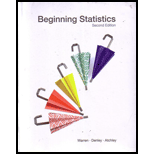
To Construct:
A 95% confidence interval for the proportion of all computer chips from one factory that are defective given that out of a random sample of 200 computer chips is obtained from the factory and 4% are found to be defective, and interpret the same.
Answer to Problem 8E
Solution:
The 95% confidence interval for the proportion of all computer chips from the factory that are defective is
Explanation of Solution
Given:
Sample size
Individual matching the given characteristic
Confidence level
Approach:
A random experiment from a population of size
Based on these numbers, the sample proportion
The sample proportions are binomially distributed (and hence are discrete), which can be approximated using a normal distribution using the continuity correction given that the sample size is large enough
The population proportion is best estimated point-wise by the sample proportion.
The margin of error is defined as the maximum distance from point estimate that the confidence interval covers.
In terms of appropriate
Where
The confidence interval bounds are equidistant from the best point estimate by the amount of margin of error as:
The number of individuals in the sample after the characteristic in the question is divided by the sample size to obtain the sample proportion which is best point estimate to the population proportion.
Then, the margin of error is computed following which, the bounds of interval estimate are obtained from the best point estimate by subtracting and adding respectively margin of error.
Calculation:
The value of
Dividing
Which gives the population proportion estimate.
Since
The critical value is looked up in the standard normal table which yields:
Then the margin of error is:
Rounding off to the
Then, lower bound of confidence interval is:
Rounding off which to the
Then, higher bound of confidence interval is:
Rounding off which to the
Thus, confidence interval is:
Conclusion:
The 95% confidence interval for the proportion of all computer chips from the factory that are defective is
Want to see more full solutions like this?
Chapter 8 Solutions
Beginning Statistics, 2nd Edition
 MATLAB: An Introduction with ApplicationsStatisticsISBN:9781119256830Author:Amos GilatPublisher:John Wiley & Sons Inc
MATLAB: An Introduction with ApplicationsStatisticsISBN:9781119256830Author:Amos GilatPublisher:John Wiley & Sons Inc Probability and Statistics for Engineering and th...StatisticsISBN:9781305251809Author:Jay L. DevorePublisher:Cengage Learning
Probability and Statistics for Engineering and th...StatisticsISBN:9781305251809Author:Jay L. DevorePublisher:Cengage Learning Statistics for The Behavioral Sciences (MindTap C...StatisticsISBN:9781305504912Author:Frederick J Gravetter, Larry B. WallnauPublisher:Cengage Learning
Statistics for The Behavioral Sciences (MindTap C...StatisticsISBN:9781305504912Author:Frederick J Gravetter, Larry B. WallnauPublisher:Cengage Learning Elementary Statistics: Picturing the World (7th E...StatisticsISBN:9780134683416Author:Ron Larson, Betsy FarberPublisher:PEARSON
Elementary Statistics: Picturing the World (7th E...StatisticsISBN:9780134683416Author:Ron Larson, Betsy FarberPublisher:PEARSON The Basic Practice of StatisticsStatisticsISBN:9781319042578Author:David S. Moore, William I. Notz, Michael A. FlignerPublisher:W. H. Freeman
The Basic Practice of StatisticsStatisticsISBN:9781319042578Author:David S. Moore, William I. Notz, Michael A. FlignerPublisher:W. H. Freeman Introduction to the Practice of StatisticsStatisticsISBN:9781319013387Author:David S. Moore, George P. McCabe, Bruce A. CraigPublisher:W. H. Freeman
Introduction to the Practice of StatisticsStatisticsISBN:9781319013387Author:David S. Moore, George P. McCabe, Bruce A. CraigPublisher:W. H. Freeman





